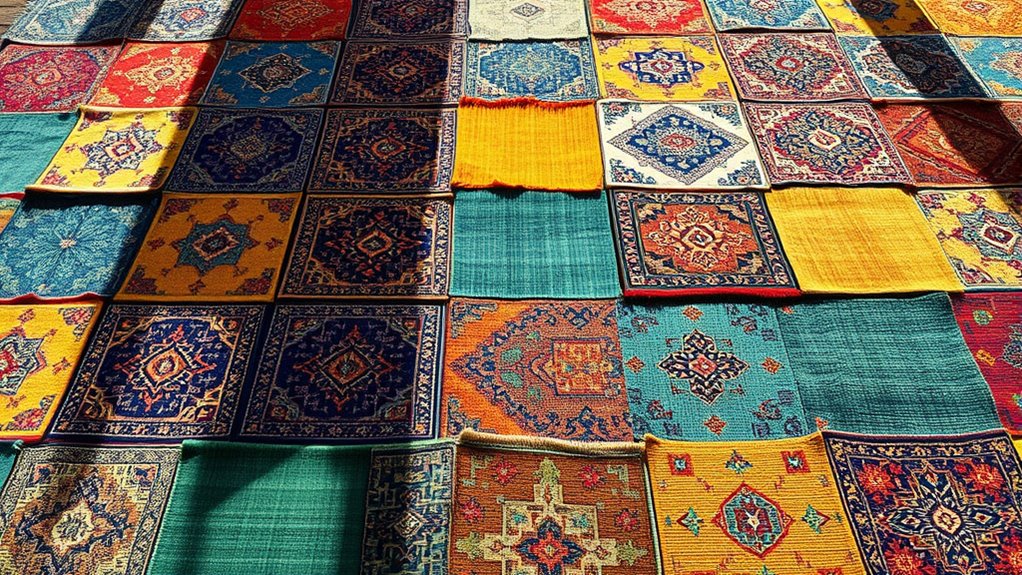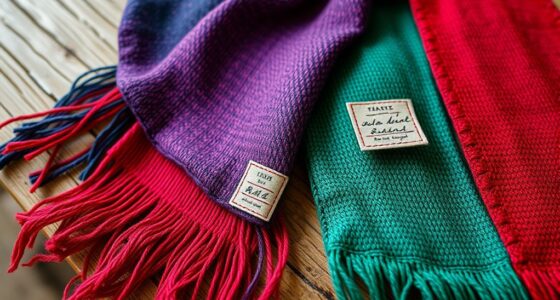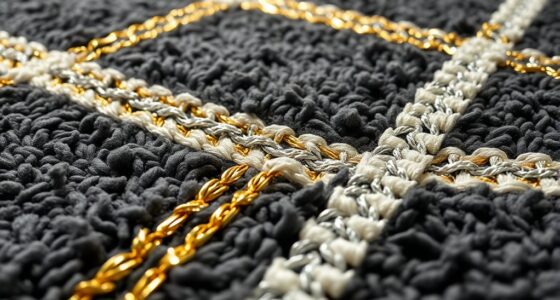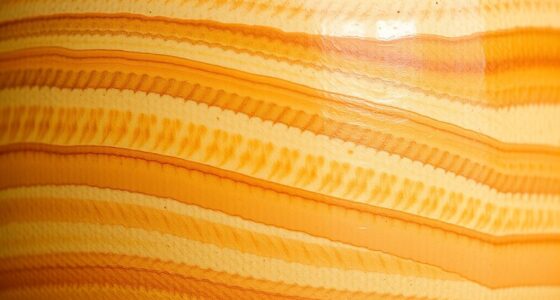Many believe that sunlight instantly ruins vegetable-dyed carpets, but that’s a myth. Properly prepared natural dyes are quite resistant to fading, especially with modern UV-protective coatings and good maintenance. Sun exposure causes gradual fading rather than quick damage, and factors like fiber type and protective measures play a big role. If you want to learn more about how sunlight affects these carpets and ways to protect them, keep exploring the facts.
Key Takeaways
- Properly prepared vegetable dyes are resistant to sunlight; fading occurs gradually, not instantly.
- UV exposure’s impact depends on duration and intensity, not merely sunlight presence.
- Modern protective coatings and treatments significantly slow vegetable dye fading over time.
- Fading from sunlight is often a slow process, allowing for effective preservation with proper care.
- Myth: Sunlight instantly destroys vegetable-dyed carpets; in reality, they can withstand sun exposure with appropriate protection.
Understanding the Composition of Vegetable-Dyed Carpets
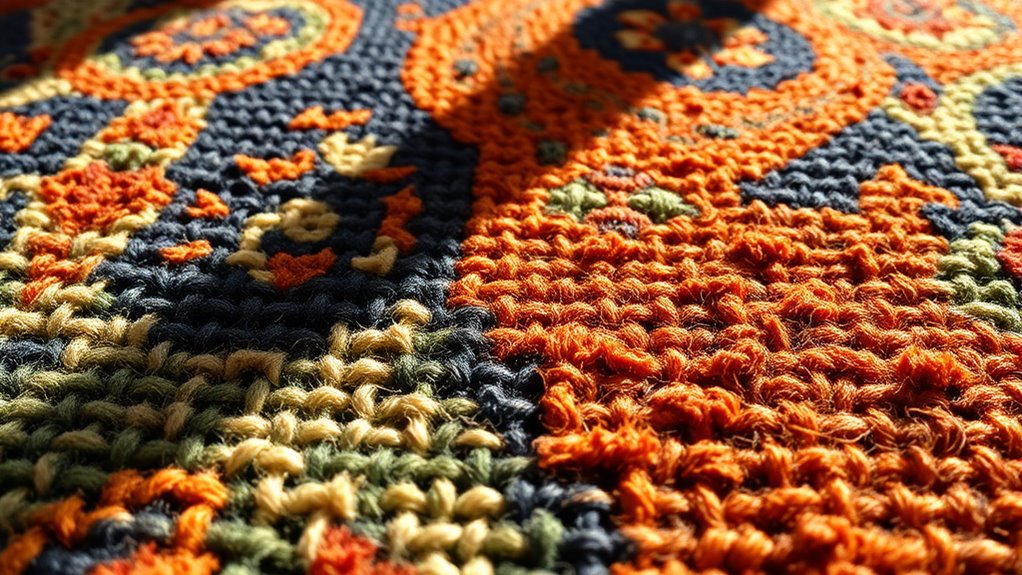
Vegetable-dyed carpets are crafted using natural plant-based pigments, which are often derived from roots, leaves, bark, or seeds. These dyes are extracted through traditional processes like boiling or fermentation, resulting in vibrant, earthy tones. Unlike synthetic dyes, vegetable dyes contain complex organic compounds that bond with fibers naturally, making each carpet unique. The fibers themselves—commonly wool, cotton, or silk—absorb the pigments differently, influencing color intensity and longevity. Because these dyes rely on natural sources, their color palette tends to be warm and subdued, with subtle variations. This composition not only adds to the aesthetic appeal but also makes vegetable-dyed carpets eco-friendly and biodegradable. Additionally, dye-fiber bonding plays a crucial role in determining how well the colors last over time. Understanding this natural process helps appreciate their beauty and the care needed to maintain their vibrant colors over time.
The Science Behind UV Light and Color Stability
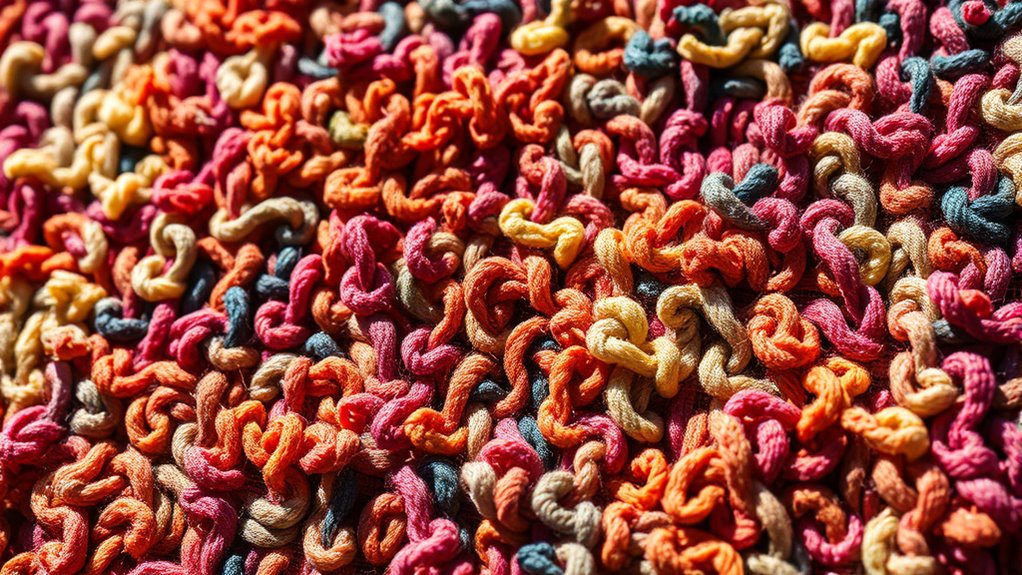
Ultraviolet (UV) light from the sun can cause dyes to fade by breaking down the chemical bonds that give colors their vibrancy. When UV rays hit vegetable dyes, they can cause molecules to break apart, leading to color loss over time. However, not all vegetable dyes are equally vulnerable; some contain natural antioxidants that protect against UV damage. The stability depends on the dye’s molecular structure and environmental factors. To understand this better, consider the table below:
| Factor | Effect on Color Stability |
|---|---|
| Molecular Structure | More complex structures resist UV breakdown |
| Presence of Antioxidants | Enhances resistance to fading |
| Exposure Duration | Longer exposure increases fading |
Additionally, advancements in UV-Protection Technologies are helping to extend the lifespan of vegetable-dyed textiles.
Common Assumptions About Sunlight and Fading

Many believe sunlight always speeds up fading and damages dyes, but that’s not always true. You might think vegetable dyes are especially fragile and easily harmed by UV exposure. However, ancient wisdom suggests that natural dyes can sometimes withstand sunlight better than synthetic ones, depending on how they are prepared and maintained. Let’s explore these assumptions and see what science really says about sunlight and fading.
Sunlight Accelerates Fading
Is sunlight really the enemy when it comes to fading textiles? The common belief is that sunlight speeds up fading, but that’s not always true. UV rays do cause some colors to fade faster, especially with synthetic dyes. However, this isn’t a blanket rule. Natural, vegetable dyes can hold their color remarkably well under sunlight, especially if they’re properly prepared and sealed. The key factor isn’t sunlight alone but how long and intense the exposure is. Short periods of sun won’t instantly ruin your carpets, and in some cases, sunlight can even help maintain fabric brightness temporarily. Additionally, fading resistance varies depending on the type of dye and the exposure conditions. So, while prolonged exposure can contribute to fading, sunlight isn’t the sole culprit, and its impact depends on the type of dye and exposure duration.
Vegetable Dyes Are Fragile
A common assumption is that vegetable dyes are particularly fragile and will quickly fade when exposed to sunlight. Many believe that these dyes can’t withstand outdoor conditions, leading people to avoid sun exposure altogether. However, research shows that vegetable dyes can be quite durable if properly prepared and applied. Their stability depends on factors like the dye’s quality, mordant used, and fabric type. Some vegetable dyes, such as indigo or madder, have proven to resist fading better than expected. While sunlight may cause gradual color changes over time, it doesn’t mean the dyes will instantly fade or disintegrate. Proper dyeing techniques and fabric treatment can enhance their longevity and resistance to sunlight. With proper care, vegetable-dyed carpets can maintain their vibrant appearance, even in sunlit areas. The idea that vegetable dyes are inherently fragile is simply a myth.
UV Exposure Is Harmful
While vegetable dyes can withstand sunlight better than commonly believed, there’s a widespread assumption that UV exposure always causes significant fading or damage. In reality, UV light’s impact depends on factors like dye type, fabric, and exposure duration. Some vegetable dyes are quite resistant, especially when protected from prolonged direct sunlight. You might think sunlight automatically ruins your carpets, but that’s not always true. Additionally, understanding Gold IRA Rollovers can inform how you diversify your investments to prepare for future financial needs.
Factors That Influence Color Retention in Natural Dyes
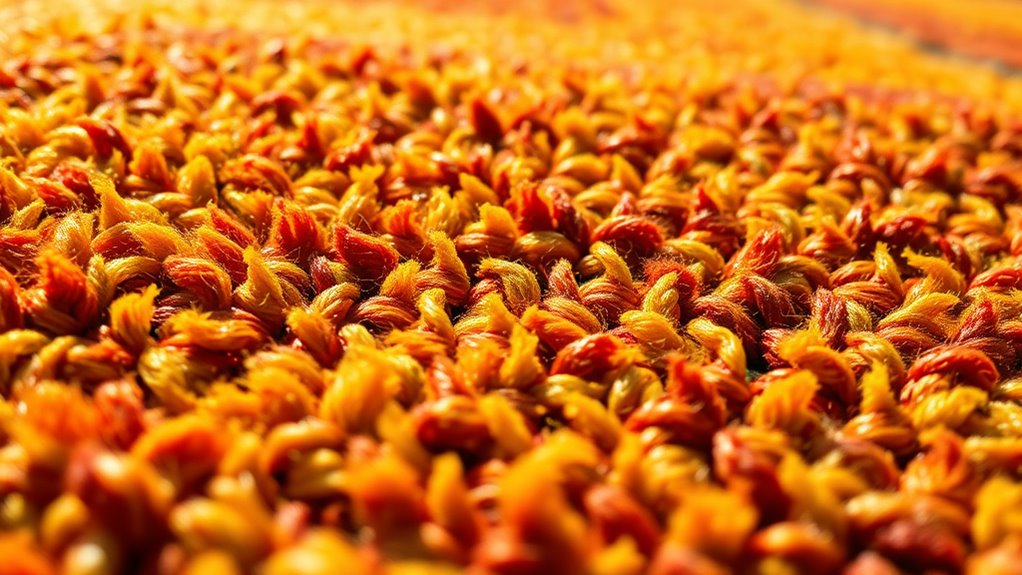
Several factors play a essential role in determining how well natural dyes retain their vibrant colors over time. First, the type of plant or source used influences colorfastness—some dyes naturally resist fading better than others. The mordant, a substance applied during dyeing, affects how firmly the dye bonds to the fiber; proper mordanting improves longevity. Fiber type also matters; natural fibers like wool and silk usually hold dyes longer than cotton or linen. Exposure to sunlight, humidity, and cleaning methods can accelerate fading, so protecting dyed items from harsh conditions helps preserve their vibrancy. Additionally, dyeing techniques and quality control during processing impact color retention. Proper mordanting techniques can significantly enhance the longevity of vegetable-dyed carpets, ensuring they maintain their beauty over time. Understanding these factors allows you to better care for vegetable-dyed carpets and enjoy their beauty over time.
Comparing Vegetable Dyes to Synthetic Alternatives
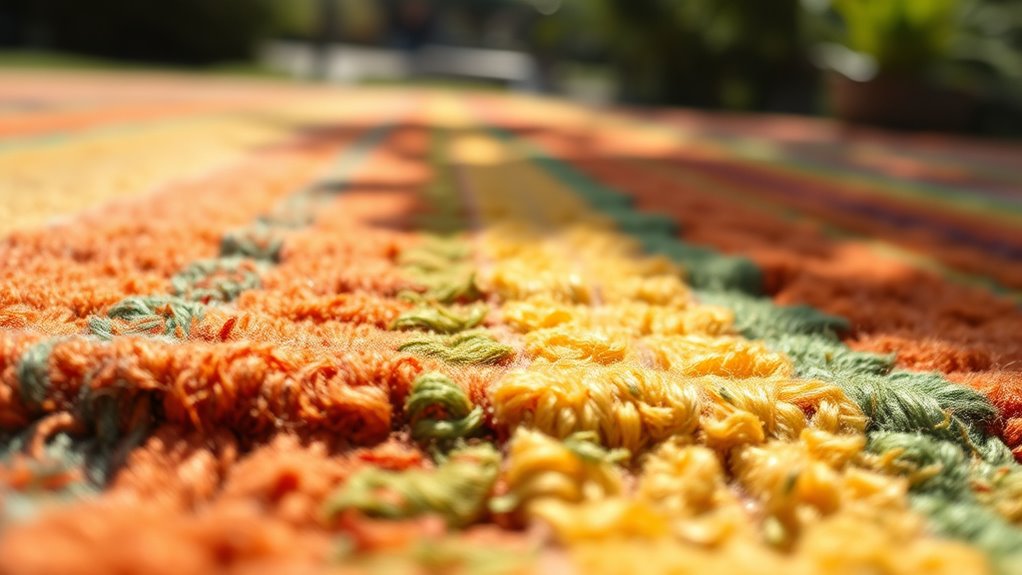
Have you ever wondered how vegetable dyes compare to synthetic alternatives regarding durability and environmental impact? Vegetable dyes are often praised for being eco-friendly, as they come from renewable, biodegradable sources like plants and roots. They typically require less energy to produce and don’t contain harmful chemicals, reducing pollution and health risks. However, they can be less colorfast and more sensitive to sunlight, leading to quicker fading if not properly protected. Synthetic dyes, on the other hand, offer vibrant, consistent colors and superior durability, especially under UV exposure. But they’re usually made from petrochemicals, which are less sustainable and can release toxic substances during manufacturing and disposal. Your choice depends on balancing environmental concerns with long-term color retention. Additionally, hackathons can serve as platforms for developing innovative eco-friendly dye technologies or sustainable textile solutions.
Real-World Examples of Sunlight-Exposed Vegetable-Dyed Carpets
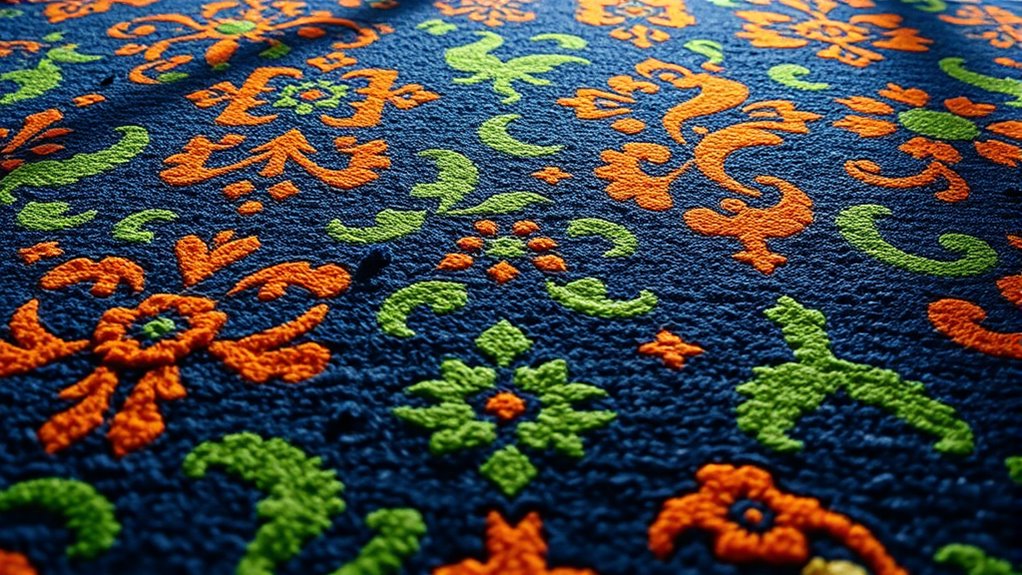
Vegetable-dyed carpets exposed to sunlight offer a clear look at how natural dyes perform in real-world conditions. You might notice that some vibrant colors fade slightly over time, but many vegetable dyes hold their hue remarkably well, especially with proper care. For example, a wool rug in a sunny living room may lose some brightness after several months, yet the overall color remains rich and appealing. In contrast, some softer shades, like pale yellows or light greens, tend to fade more noticeably. However, these changes often add a warm, vintage charm rather than a sign of deterioration. Regular maintenance and proper cleaning techniques can help preserve the vibrancy of vegetable dyes, ensuring the carpets maintain their beauty longer. These real-world examples show that while vegetable dyes can fade, they usually do so gradually, maintaining their beauty and character long-term when exposed to sunlight responsibly.
Tips for Protecting Your Carpet While Enjoying Sunlight
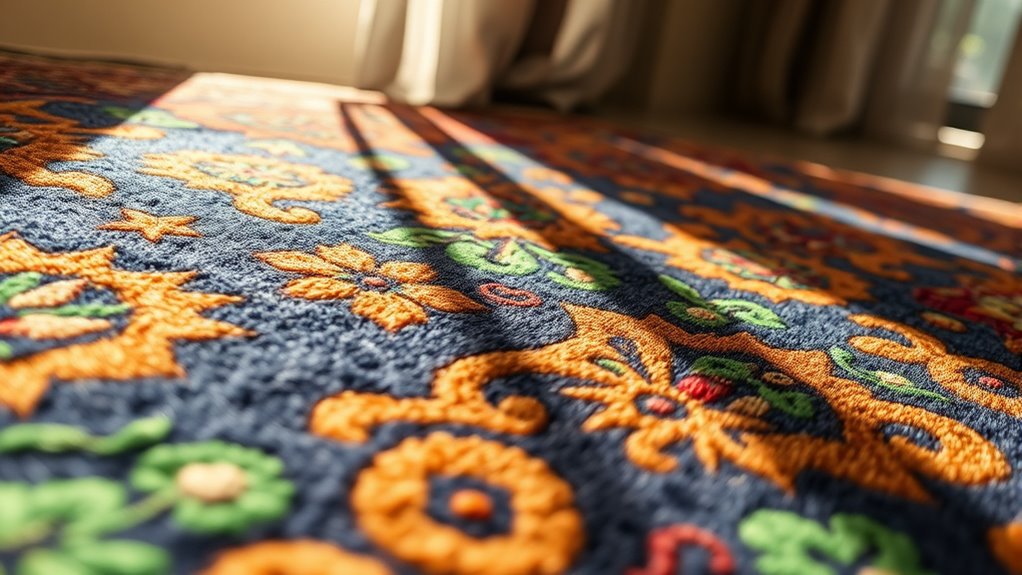
To enjoy sunlight in your home without compromising your carpet’s beauty, it’s essential to take proactive steps to safeguard it. First, use UV-protective window films or treatments to block harmful rays. Second, rotate your carpets regularly to ensure even exposure and prevent uneven fading. Third, place curtains or blinds during the brightest parts of the day to minimize direct sunlight. Fourth, consider adding area rugs or furniture to shield vulnerable sections. These simple actions help preserve vibrant colors and prevent fading caused by UV rays. Additionally, choosing appropriate textiles that resist fading can further enhance your efforts. These simple actions help preserve vibrant colors and prevent fading caused by UV rays. By implementing these tips, you can bask in sunlight while maintaining your carpet’s original charm and color integrity. Protecting your investment ensures your home stays bright and beautiful for years to come.
Myths Versus Facts: What Experts Say
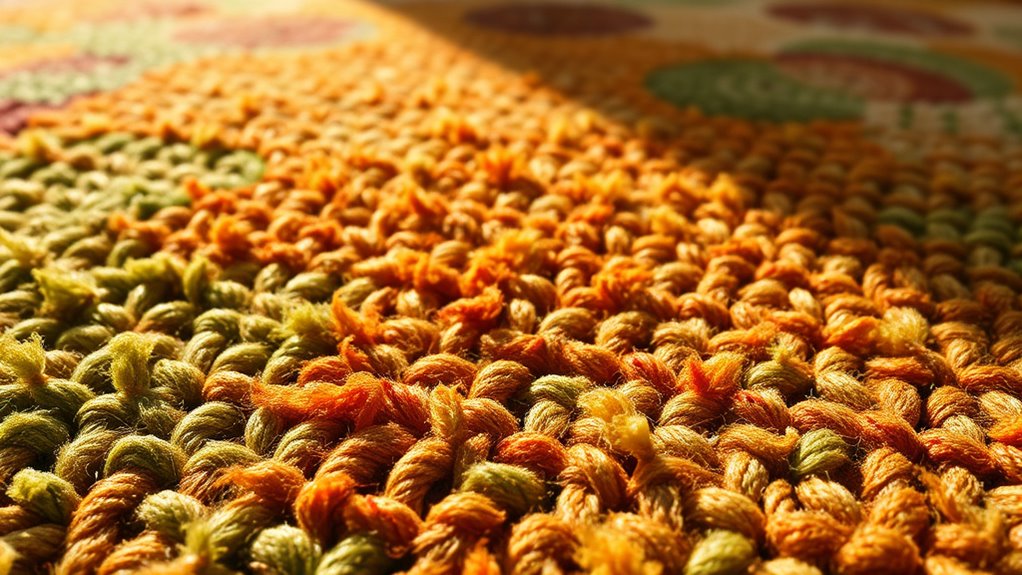
Many common beliefs about UV fading are actually myths, and understanding the facts can help you better protect your carpets. Experts agree that vegetable dyes aren’t as vulnerable to sunlight as many think. While UV exposure can cause fading, the idea that sunlight instantly ruins dyed carpets is misleading. In reality, fading occurs gradually over years, not days or weeks. Most professionals confirm that modern protective measures, like UV-resistant coatings or proper placement away from direct sunlight, considerably slow this process. Additionally, experts highlight that quality dyes and fibers are designed to resist fading better than older, cheaper options. So, instead of fearing sunlight entirely, focus on proper care and preventive measures to preserve your carpet’s color and beauty longer.
Innovative Treatments and Techniques to Enhance Durability
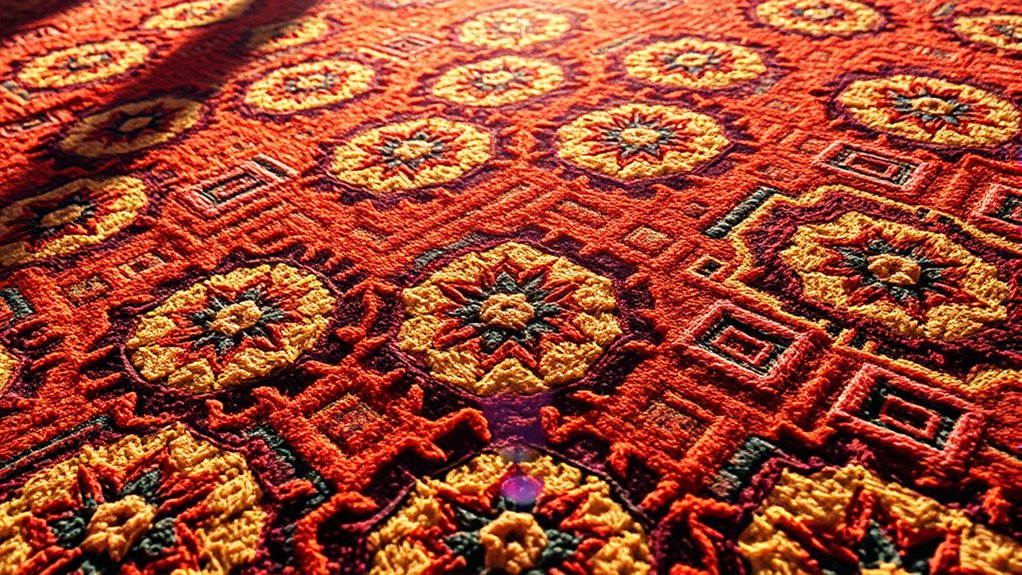
Innovative treatments like UV-resistant coatings and advanced dye stabilizers can considerably boost the durability of your materials. These solutions help protect against fading caused by sunlight exposure, extending the lifespan of your items. Exploring these techniques lets you stay ahead of UV damage and maintain their vibrant appearance.
UV-Resistant Coatings
UV-resistant coatings have advanced considerably through innovative treatments that enhance durability and prolong the lifespan of materials exposed to sunlight. These coatings act as a protective barrier, absorbing or reflecting harmful UV rays before they reach the surface. To maximize effectiveness, manufacturers often:
- Incorporate UV-absorbing agents that dissipate UV energy harmlessly.
- Use nano-technology to create ultra-thin, durable layers.
- Apply polymer-based films that resist cracking and peeling.
- Integrate antioxidants to prevent chemical breakdown over time.
These improvements help maintain the original color and texture of vegetable-dyed carpets, reducing fading. By choosing the right UV-resistant coating, you can profoundly extend the life of sun-exposed textiles and keep their vibrant appearance intact.
Advanced Dye Stabilizers
Advanced dye stabilizers play a crucial role in preserving the vibrancy and longevity of colors exposed to sunlight. These innovative treatments work by chemically modifying dyes or adding protective agents that resist fading. For vegetable-dyed carpets, stabilizers help prevent pigment breakdown caused by UV rays, extending their lifespan. You can choose stabilizers formulated specifically for natural dyes, which enhance colorfastness without altering the appearance. Applying these stabilizers during manufacturing or as a finishing treatment offers a proactive approach to durability. They create a barrier that minimizes photo-degradation, ensuring your carpets maintain their rich hues over time. By incorporating advanced stabilizers, you’re investing in a solution that fights fading at the molecular level, giving your natural-dyed carpets a much-needed boost against sunlight’s damaging effects.
Making Informed Choices for Your Home Decor
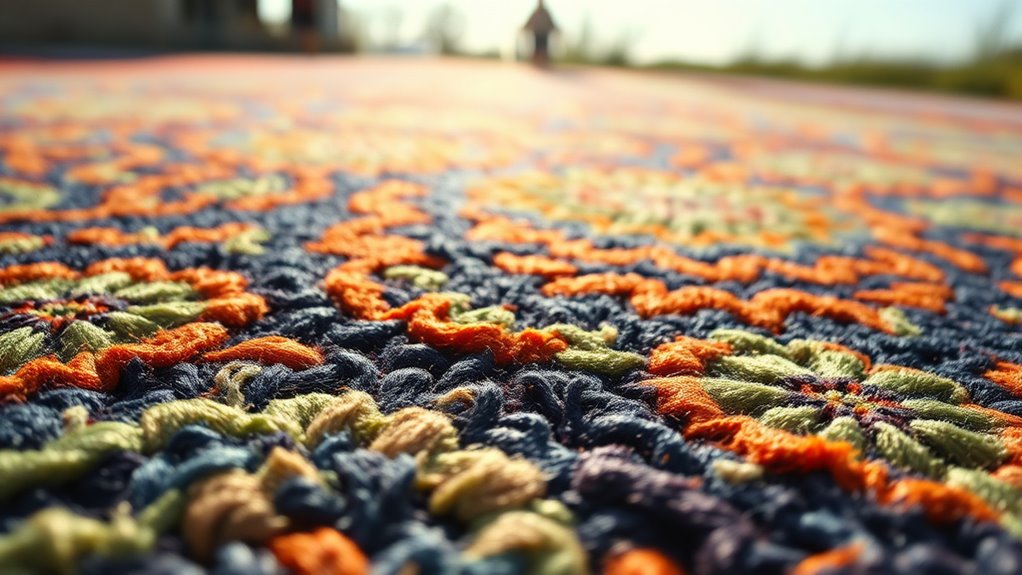
When choosing home decor items, it’s essential to take into account how sunlight exposure might affect their appearance over time. To make informed decisions, consider these steps:
- Assess sunlight levels: Determine how much direct sunlight each area receives daily.
- Select durable materials: Pick fabrics and finishes designed to resist fading.
- Use window treatments: Install curtains or blinds to limit sun exposure on delicate items.
- Rotate decor regularly: Shift rugs and furniture to distribute sunlight evenly, preventing uneven fading.
Frequently Asked Questions
Do All Vegetable Dyes Fade Equally Under Prolonged Sunlight Exposure?
You might wonder if all vegetable dyes fade equally when exposed to prolonged sunlight. The truth is, it varies depending on the specific dye and fiber type. Some vegetable dyes are more lightfast, resisting fading better, while others fade quickly. Factors like dye concentration and sunlight intensity also play roles. So, don’t assume all vegetable dyes behave the same; their longevity depends on specific dyes and environmental conditions.
How Does the Type of Vegetable Dye Affect Its UV Resistance?
Oh, the great vegetable dye debate—who knew plant pigments could be so dramatic? Your choice of vegetable dye deeply impacts UV resistance; some are like sun-worshippers, fading quickly, while others are more resilient, hiding their secrets beneath vibrant hues. Typically, natural indigos and tans resist sunlight better than bright reds or yellows, which tend to fade faster. So, choose your dyes wisely if you want your carpet to stay lively under the sun’s watchful eye.
Can Uv-Fading Be Completely Prevented With Modern Treatments?
You might wonder if UV-fading can be fully prevented with modern treatments. While advancements have improved UV protection, complete prevention isn’t guaranteed. Treatments like UV stabilizers and protective coatings considerably slow fading, but exposure to intense or prolonged sunlight can still cause discoloration over time. So, if you want your carpets to stay vibrant, it’s best to limit direct sunlight or use window coverings, even with modern UV-resistant options.
Are Certain Home Environments More Suitable for Vegetable-Dyed Carpets?
Think of your home as a garden where some plants thrive better than others. Certain environments with minimal direct sunlight and stable temperatures are more suitable for vegetable-dyed carpets. You’ll want to avoid bright windows and areas with harsh UV exposure. By creating a shaded, climate-controlled space, you help preserve your carpet’s vibrant colors, making your home a nurturing environment for these natural dyes to shine without fading prematurely.
What Are the Long-Term Color Retention Expectations for Vegetable-Dyed Carpets?
You might wonder about how well vegetable-dyed carpets hold their color over time. Generally, they tend to fade more quickly than synthetic dyes, especially with frequent exposure to sunlight. However, if you keep your carpet away from direct sunlight and follow proper care instructions, you can help preserve its vibrant hues longer. Expect some fading over years, but with attentive maintenance, your vegetable-dyed carpet can stay beautiful for quite a while.
Conclusion
Now that you know the truth about vegetable-dyed carpets, you can enjoy sunlight without worry. You can protect your investment, preserve your colors, and enjoy natural beauty. You can choose wisely, maintain carefully, and appreciate naturally dyed textiles. By understanding the science, debunking the myths, and applying expert tips, you empower yourself to make informed decisions. Embrace sunlight, safeguard your carpets, and celebrate the enduring charm of vegetable dyes in your home.
